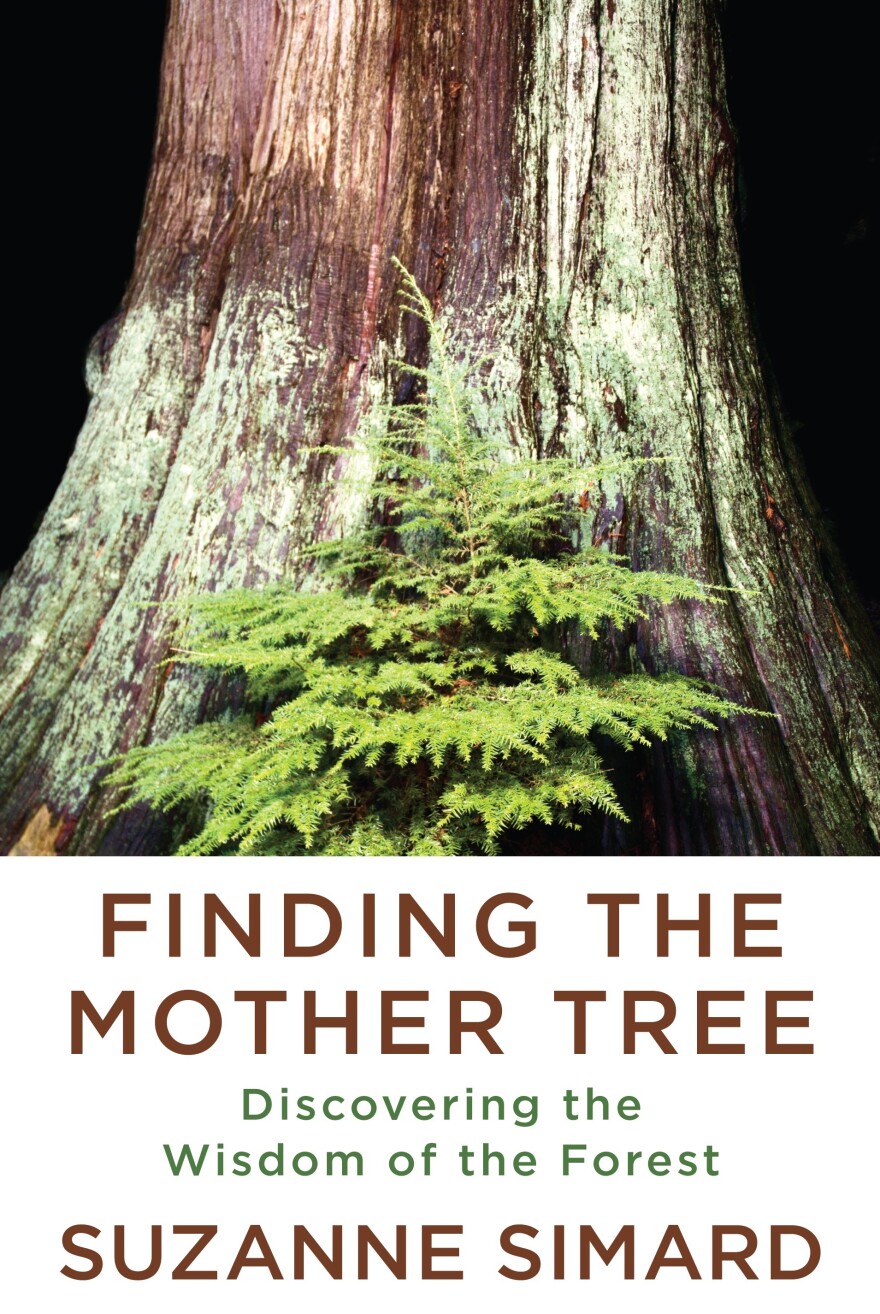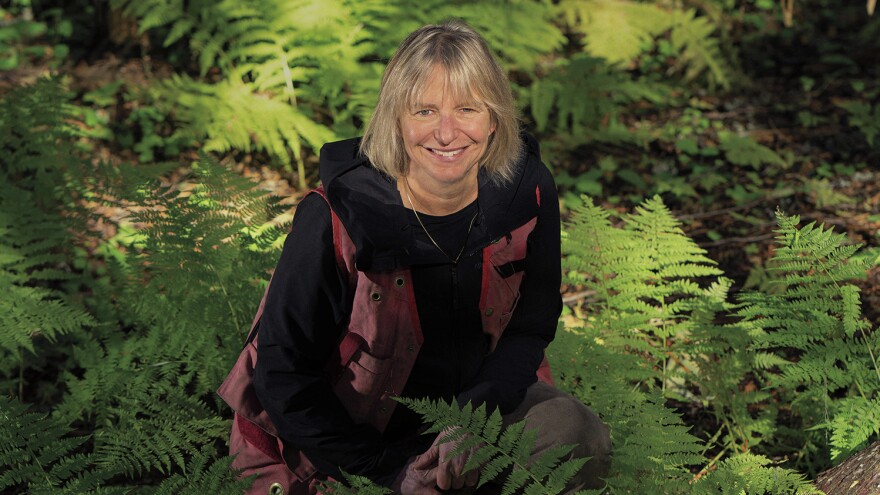Trees are "social creatures" that communicate with each other in cooperative ways that hold lessons for humans, too, ecologist Suzanne Simard says.
Simard grew up in Canadian forests as a descendant of loggers before becoming a forestry ecologist. She's now a professor of forest ecology at the University of British Columbia.
Trees are linked to neighboring trees by an underground network of fungi that resembles the neural networks in the brain, she explains. In one study, Simard watched as a Douglas fir that had been injured by insects appeared to send chemical warning signals to a ponderosa pine growing nearby. The pine tree then produced defense enzymes to protect against the insect.
"This was a breakthrough," Simard says. The trees were sharing "information that actually is important to the health of the whole forest."
In addition to warning each other of danger, Simard says that trees have been known to share nutrients at critical times to keep each other healthy. She says the trees in a forest are often linked to each other via an older tree she calls a "mother" or "hub" tree.
"In connecting with all the trees of different ages, [the mother trees] can actually facilitate the growth of these understory seedlings," she says. "The seedlings will link into the network of the old trees and benefit from that huge uptake resource capacity. And the old trees would also pass a little bit of carbon and nutrients and water to the little seedlings, at crucial times in their lives, that actually help them survive."
The study of trees took on a new resonance for Simard when she was diagnosed with breast cancer. During the course of her treatment, she learned that one of the chemotherapy medicines she relied on was actually derived from a substance some trees make for their own mutual defense. She explains her research on cooperation and symbiosis in the forest, and shares her personal story in the new memoir Finding the Mother Tree: Discovering the Wisdom of the Forest.
Interview Highlights

On working for a logging company in British Columbia in her 20s
It was the late 1970s when I started; they were clear-cutting and just starting to plant trees. And so, of course, this was completely different than what I saw my grandfather do and my dad and uncles. They just took out the odd tree here and there. But this was wholesale taking out all the trees, the big ones and the little ones. And that was my first job in the forest industry, which to me was quite shocking. But it was also extremely exciting because it was so dangerous. And I was also one of the first girls to be in the industry.
On being a young forester and realizing that fungus was key to the health of a forest
In the forest floor ... there's all kinds of bugs, but there's also lots of fungi. And the fungi are so colorful. There's yellow ones and purple ones and white ones and ... they grow right through the forest floor to the point where it kind of looks like gauze, almost. And so I was finding this yellow fungus. And yet, when I pulled up the seedlings that were not doing so well — they were yellow and dying — I realized that their roots were kind of black and straight. ... And so I wondered, what were they missing? Were they missing this fungus? Was this fungus ... a pathogen or was it a helper fungus?
And eventually I learned that these were a special kind of helper fungus called a mycorrhizal fungus — which just means that the fungus is the type that grows through the soil and picks up nutrients and water and brings it back to the seedling. ... So eventually, I was able to put together that these little seedlings that were not doing so well were missing their mycorrhizal fungi.
On the critical relationship between trees and fungi
Keep in mind that all trees and all plants — except for a very small handful of plant families — have obligate relationships with these fungi. That means that they need them in order to survive and grow and produce cones and have fitness — in other words, to carry their genes to the next generations. And the fungi are dependent on the plant or the trees ... because they don't have leaves themselves [for photosynthesis]. And so they enter into this symbiosis in that they live together in the root, and they exchange these essential resources: carbohydrates from the plant for nutrients from the fungus, in this two-way exchange which is very tight, almost like a market exchange. If you give me five bucks, I'll give you five bucks back. It's very, very tightly regulated between those two partners in the symbiosis. But, yes, all trees and all plants in all of our forests around the world are dependent on this relationship.
On how trees can help each other by sharing nutrients
[At the time] birches were considered weeds. There was a huge program to spray and herbicide these trees to get rid of them because the foresters viewed the birches as competing with Douglas fir, competing for light especially. I was observing in these plantations, though, that when they weeded out the birches, when they sprayed them or cut them, that there was a disease in the forests that would just start spreading like a fire. It was called Armillaria root disease. I really thought, we're doing something wrong here. And so I wanted to know whether the birches were somehow protecting the firs against this disease and that when we cut them out it actually made it way worse.
I had learned about these mycorrhizal fungi and how they could actually protect trees against diseases. And I'd also heard about David Reed's work in the U.K., where he had shown that in the laboratory that trees could be linked together by mycorrhizal fungi and pass carbon between them. So I tested this between birch and fir in my sick plantations.
I planted birch and fir and cedar together in little triplets. ... And I traced how those carbon molecules went back and forth between the birch and fir and they didn't actually end up in the cedars. Because the cedars, they form a different kind of mycorrhizal fungus that doesn't associate with either birch or fir. So [the cedar] wasn't actually in the network with birch and fir, and it picked up hardly any of this isotope.
I knew that birch and fir were sharing carbon below ground — much against the prevailing wisdom that they only compete for light and also that the more that birch shaded Douglas fir, the more carbon was sent over to Douglas fir. So there was a net transfer from birch to fir that was sort of mitigating its shading effect.
In this way the ecosystem was maintaining its balance — the birch and fir could coexist because of this collaborative behavior that was sort of offsetting some of the competition that was going on.
On the ways her own breast cancer diagnosis shaped her research
It definitely had a big influence on me, and my life has changed as a result, but it changed my research, too. That was when I started working with kin recognition, seeing whether or not these old trees, especially when they were dying, could recognize and help their kin. And I had graduates come on to actually ask those questions. You know, if a tree is dying, do they send more [nutrients and other signals] to their kin? And we found that they do.
Then I also started some research — one of the main chemotherapy medicines that was administered to me was paclitaxel [also called Taxol]. Paclitaxel is a defense agent — actually a defense chemical — that is produced by the Pacific yew tree, or all yews around the world, actually. It was essential to my recovery — this compound that trees produce to defend themselves against diseases.
And so I thought, you know what, I want to find out more about this. I started a study with a new graduate student, Eva, and she is looking at the neighborhood of yews — whether they're associated with old cedars and maples, and how their neighbors might influence their ability to produce high-quality Taxol to increase their defense.
We just found out that these trees are all connected together by this muscular mycorrhizal network, which provides the avenues for them to communicate this information. So, yeah, we're embarking on that work. I'm hopeful that it will help us to, for one thing, conserve these trees for their medicinal qualities — because they are ingenious in what they've done. They've evolved these, what we call medicines, but they're for themselves to defend themselves against illness as well. The cancer treatment is what drove me to do this study. And I'm so excited to find out what we learn.
On why it's important to let an old tree go through the long dying process on its own
[Trees] get old. They do eventually decline. And dying is a process, and it takes a long, long time. It can take decades for a tree to die. In the process of dying, there's a lot of things that go on. And one of the things that I studied was where does their energy — where does the carbon that is stored in their tissues — where does it go? And so we label some trees with carbon dioxide — with C13, which is a stable isotope — and we watched as we actually cause these trees to die. We stress them out by pulling their needles off and attacking them with budworms and so on. And then we watched what happened to their carbon.
And we found that about 40% of the carbon was transmitted through networks into their neighboring trees. The rest of the carbon would have just dispersed through natural decomposition processes ... but some of it is directed right into the neighbors. And in this way, these old trees are actually having a very direct effect on the regenerative capacity of the new forest going forward.
This is a completely different way of understanding how old trees contribute to the next generations — that they have agency in the next generations. And our practices of salvage logging to get rid of dying trees, or trees that have just died or have been burned in wildfires — if we go in and cut them right away, we're actually short-circuiting that natural process.
Our studies suggest it would have knock-on effects to the regeneration coming up. They're not going to be as well prepared for their lives coming forward. So I've been trying to tell people: Let's hold back on this salvage logging until trees have had the chance to pass on this energy and information to the new seedlings coming up.
Sam Briger and Thea Chaloner produced and edited this interview for broadcast. Bridget Bentz, Molly Seavy-Nesper and Deborah Franklin adapted it for the web.
Copyright 2021 Fresh Air. To see more, visit Fresh Air. 9(MDA1MTkyNjA1MDEyNzM1MTQ0ODk3NTA1NA004))



